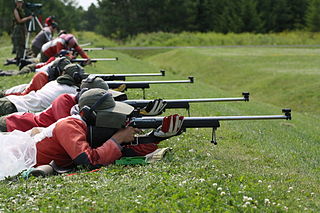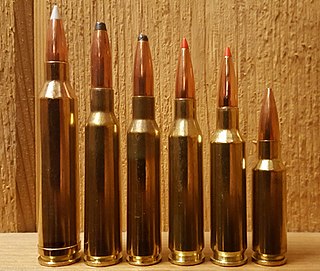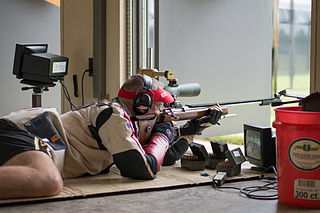
Shooting sports is a group of competitive and recreational sporting activities involving proficiency tests of accuracy, precision and speed in shooting — the art of using ranged weapons, mainly small arms and bows/crossbows.

This is a table of selected pistol/submachine gun and rifle/machine gun cartridges by common name. Data values are the highest found for the cartridge, and might not occur in the same load.

The .338 Lapua Magnum is a Finnish rimless, bottlenecked, centerfire rifle cartridge. It was developed during the 1980s as a high-powered, long-range cartridge for military snipers. Due to its use in the War in Afghanistan and the Iraq War, the cartridge has become widely available.

The International Practical Shooting Confederation (IPSC) is the world's largest shooting sport association, and the largest and oldest within practical shooting. Founded in 1976, the IPSC nowadays affiliates over 100 regions from Africa, Americas, Asia, Europe, the Middle East, and Oceania. Competitions are held with pistols, revolvers, rifles, and shotguns, and the competitors are divided into different divisions based on firearm and equipment features. While everyone in a division competes in the Overall category, there are also separate awards for the categories Lady, Super Junior, Junior, Senior, and Super Senior.

Benchrest shooting is a shooting sport discipline in which high-precision rifles are rested on a table or bench – rather than being carried in the shooter's hands – while shooting at paper or steel targets, hence the name "benchrest". Both the forearm and buttstock of such a rifle are usually fully supported by bean bags, a bipod/monopod (front/rear) combination, and/or a specially designed fixture device called shooting rest, so that the gun can remain stably pointing at the target without needing to be held by someone. When shooting, the shooter simply sits/stands comfortably behind the table/bench, operates the action and pulls the trigger, without needing to worry about carrying any weight of the gun. This is in contrast to other shooting disciplines, where the shooter has to bear at least part of the gun's weight while holding it steady to aim, even when using support devices such as bipods, tripods or shooting sticks.

Fullbore Target Rifle (TR) is a precision rifle shooting sport discipline governed by the International Confederation of Fullbore Rifle Associations (ICFRA). The sport evolved as a distinct British and Commonwealth of Nations discipline from Service rifle (SR) shooting in the late 1960s. Its development was heavily influenced by the British National Rifle Association (NRA). Due to this history, it is usually contested amongst the shooting events at the Commonwealth Games, although not at the Olympics. World Championships are held on a four-year cycle. The annual NRA Imperial Meeting at Bisley in the UK is globally recognised as an historic annual meeting for the discipline.
The .408 Cheyenne Tactical (designated 408 Chey Tac by the C.I.P. is a specialized rimless, bottlenecked, centerfire cartridge for military long-range sniper rifles that was developed by Dr. John D. Taylor and machinist William O. Wordman. The round was designed with a possible military need for a cartridge for anti-personnel, anti-sniper, and anti-materiel roles with a precision range of 2,200 yards. It is offered as a competitor to the most common military NATO long-range service cartridges such as .338 Lapua Magnum and the .50 BMG.
The 6.5×47mm Lapua is a smokeless powder rimless bottlenecked rifle cartridge that was developed specifically for 300–1,000 m (328–1,094 yd) competition shooting by ammunition maker Nammo Lapua and the Swiss rifle manufacturer Grünig & Elmiger AG in 2005. Other common names for this cartridge include 6.5×47mm.

The 6.5mm Creedmoor (6.5×48mm), designated 6.5 Creedmoor by SAAMI, 6,5 Creedmoor by the C.I.P. is a centerfire rifle cartridge introduced by Hornady in 2007. It was developed by Hornady senior ballistics scientist Dave Emary in partnership with Dennis DeMille, the vice-president of product development at Creedmoor Sports, hence the name. The cartridge is a necked-down modification of the .30 Thompson Center.

The .338 Norma Magnum is a cartridge first introduced in 2008 and came into production in 2009, designed by Norma of Sweden.
The SIG Sauer 200 STR, also known as the SIG Sauer 200 STR Match, is a bolt-action rifle mostly used as a target/competition rifle for national competitions by Norwegian, Swedish and Danish sport shooters. It is a variant of the Sauer 200 TR or SIG Sauer 200 TR Match rifle that features thicker 19 mm (0.75 in) diameter barrels. The 200 STR is produced by J. P. Sauer & Sohn GmbH in Germany.
The .300 Norma Magnum, also known as .300 NM or 300 Norma, is a centerfire magnum rifle cartridge developed by Swedish ammunition manufacturer Norma Precision. The .300 Norma Magnum uses a .338 Norma Magnum parent case necked down to .30 caliber, named to differentiate it from the older .308 Norma Magnum designed in 1960, and has begun to gain popularity among long-range shooters. According to the official C.I.P. rulings, the .300 Norma Magnum can handle up to 440.00 MPa (63,817 psi) Pmax piezo pressure.

Long range shooting is a collective term for shooting disciplines where the distance to target is significant enough that shooter has to put effort into calculating various ballistic factors, especially in regards to the deviating effects of gravity and wind. While shooting at shorter ranges, a shooter only has to slightly adjust the sights to compensate for limited bullet drop at most, but when the range is extended, wind drift will be the first factor affecting precision to the extent that it must be taken into serious account. Some would argue that long range shooting starts where assessment of wind, distance and various atmospheric conditions are equally important for the results as pure shooting skills - meaning that even if one conducts a technically perfect shot, the shooter will miss the target because of incorrect calculations, neglecting to take some elements into consideration, or merely due to unpredictable downrange conditions. It is widely accepted within interdisciplinary circles that for a standard rifle firing full-powered cartridges, "long range" means the target is more than 600 m (660 yd) away,, while "extreme long range" is generally accepted as when the target distance is more than 1,000 m (1,100 yd) away from the shooter.

Bullseye shooting is a category of shooting sport disciplines where the objective is to score points with carefully placed precision fire by hitting a target as close to its center as possible. The name refers to the target center's nickname, the "bull's eye". In Scandinavia, this type of shooting competition is referred to as Range-Shooting, as it usually takes place at dedicated shooting range.
Precision Rifle Series (PRS) is an American long-range and precision rifle-based shooting sport derived from practical shooting. The series have a championship style where competitors collect points from 45 matches spread across nearly twenty U.S. states, and thereby are ranked across the nation. Top ranked competitors get to compete in the last match of the season which is the "Precision Rifle Finale". The number of active competitors has increased from 164 in 2012 to over 15,000 by 2023.

The French Shooting Federation (FFTir), FrenchFédération Française de Tir, is the umbrella organization for sport shooting in France. It was founded in its current form in 1967, but has roots as far back as 1866.
PRS Norway is a Norwegian sports association for field based long range and precision shooting competitions with fullbore rifles. It is the Norwegian representative of the International Precision Rifle Federation, and can be viewed as the Norwegian version of the American PRS Series. Norwegian competitions are arranged in a cup format similar to the U.S. version

The International T-Class Confederation (ITCC), founded in 2014, promotes the shooting sport of T-Class which is mainly focused on competitions with precision rifle systems for various short, medium and long range distances, which may either be known or unknown. Headquarters reside in Bulgaria, and for the purpose of promotion of the sport internationally the organization offers a ruleset which regulates the design and management of competitions.
The Swedish Shooting Sport Federation is a Swedish sport shooting association founded in 2009 by merging the three former organisations Swedish Sport Shooting Association, Frivilliga Skytterörelsen (FSR) and Skytterörelsens Ungdomsorganisation. In addition to being their well-known Nordic shooting disciplines, they are also affiliated internationally with the International Shooting Sport Federation (ISSF), Fédération Internationale de Tir aux Armes Sportives de Chasse (FITASC) and the International Precision Rifle Federation (IPRF).










